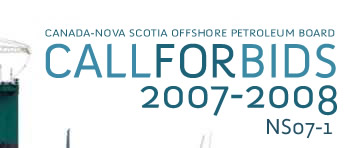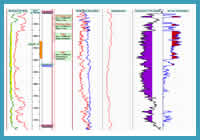
CANADA-NOVA SCOTIA OFFSHORE PETROLEUM BOARD


Formation Evaluation
Eagle D-21 is the only well located on Parcel 2. A detailed petrophysical assessment was conducted on Eagle D-21. The results of this assessment are presented below.
In Eagle D-21, a few minor scattered gas shows were encountered in the Missisauga formation from 4100 m – 4660 m (TD), however none of these sands are interpreted to contain significant hydrocarbon accumulations. The main reservoir in Eagle is the Wyandot formation which has a gross thickness of 190 m, at the D-21 well, and consists of interbedded limestones, marls and chalks. The Wyandot reservoir is normally pressured, however slight overpressuring was detected near the base of the well in the Missisauga formation.
A complete suite of primary logging measurements (i.e. GR, SP, Caliper, Density, Neutron, Sonic, Dual Induction-Laterolog) were acquired over most of the well, including the Wyandot. In addition, three continuous conventional cores were cut in the Wyandot reservoir interval, shown in Figure 18. The conventional core intervals are listed below.
| Core# | Interval (m MD) |
Recovery |
| Core# 1 | 1638.6 – 1649.0 m |
Rec. 9.4 m |
| Core# 2 | 1649.0 – 1658.4 m |
Rec. 8.8 m |
| Core# 3 | 1658.4 – 1667.6 m |
Rec. 8.7 m |
Routine core analysis was conducted on the above cores. Core porosities range from 19 - 36% with an average of 28%, while permeabilities range from 0.2 – 50 mD with an average of 0.6 mD. Core plugs containing fractures typically had the highest permeability. Core permeabilities are generally <2.0 mD, however all plugs had measured permeabilities above the 0.1 mD reservoir cutoff typically used for gas reservoirs.
Three Production Tests were conducted in the Wyandot formation, shown in Figure 18. Each zone was acidized prior to testing to improve deliverability. The well test results are summarized below.
| Production Test# | Top (m MD) |
Base (m MD) |
Gas Rate (MMscf/d) |
Condensate Rate (M3/d) |
Condensate Rate (Bbls/d) |
Water Rate (M3/d) |
Water Rate (Bbls/d) |
| PT# 1 | 1659.6 |
1666.0 |
1600.6 |
0 |
0 |
Trace |
Trace |
| PT# 2 | 1622.8 |
1638.6 |
1300.3 |
0 |
0 |
8* |
50* |
| PT# 3 (upper perfs)** |
1594.1 |
1603.2 |
1400.4 MMscf/d decreasing to 150 Mscf/d |
0 |
0 |
0 |
0 |
| PT# 3 (lower perfs)** |
1608.1 |
1615.4 |
* The salinity of the recovered water in PT# 2 was 16,000 ppm while the salinity of the formation water is estimated to be 85,000 ppm, which suggests the produced water is likely mud filtrate.
** In PT# 3 the upper and lower perforations were tested together.
A petrophysical assessment of the Eagle D-21 well was conducted using all available log, core and test data (Figure 18). A log defined gas-water contact (GWC) was interpreted at 1680.3 m MD / -1650.1 m TVD-SS. Due to the limited matrix permeability of the Wyandot a considerable transition zone, caused by capillary pressure effects, is evident on logs. This transition zones extends approximately 30 m above the GWC.
The results of the CNSOPB petrophysical assessment are summarized below.
Zone |
Top (m MD) |
Base (m MD) |
Net Pay (m TVD) |
Net Pay Por. (%) |
Net Pay Perm. (mD) |
Sw (%) |
Wyandot |
1592.3 |
1782.2 |
52 |
27 |
0.50 |
54 |
